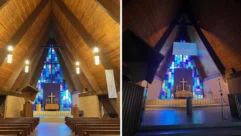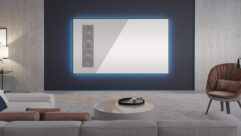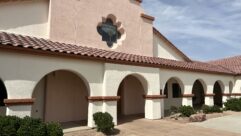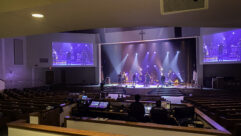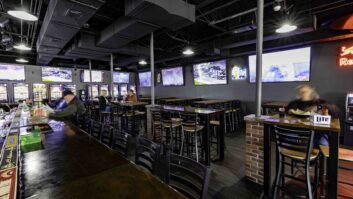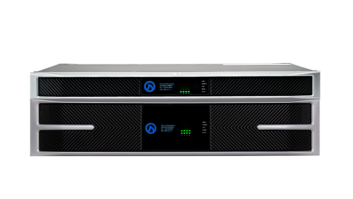SVC Podcast – Show Notes –
In this edition of the SVC Podcast, Contributing Editor Bennett Liles concludes his talk with Steve Diamond of Diamond Support Services about an installation at Calvary Lutheran Church in Grants Pass, Oregon. To complement the two new Eiki EK-810U WUXGA 8,000 lumen projectors, Steve also installed two Crystal Screens Reflect 3.0 projection screens. These were suspended in front of each front wall of the church. He also provides details on the sound system upgrade done for the church.
Links of Interest:
- Crystal Screens Reflect 3.0 projection screens
- Allen & Heath GLD Series digital mixing consoles
- Shure QLX-D digital microphones for the church sound system upgrade
- DPA headset microphones used by the church vocalists
Download Podcast Here:
https://s3.amazonaws.com/nb-svc/public/public/190-2_Diamond_Support_Svcs…
This is the SVC Podcast from Sound & Video Contractor Magazine with Steve Diamond of Diamond Support Services. Show notes and product links for this podcasts others are at svconline.com.
Even in a traditional church, things have to evolve and at Calvary Lutheran Church in Grants Pass, Oregon their old projection and sound systems were difficult to use. Diamond Support Services put in two new projectors, hung screens and revamped the sound system. Steve Diamond is back to finish up with their sound system upgrade. Next up on the SVC Podcast.
Steve, good to have you back and we were talking last week about the Calvary Lutheran Church and the effect that the new Eiki EK-810U projectors had on the congregation there. Let’s go to the screens though. What was behind the selection of the Crystal Screens display surfaces?
Well, you know, as I told you last time we spoke that three of the walls are window walls, basically. They’re glass – predominantly glass – and we had a tremendous amount of horizontal light that we’re dealing with that has to be overcome to give a good picture. Crystal Screens is one of only just a couple of companies using a new screen material that rejects ambient light and really gives you a clear picture from the projector, but gets rid of all that horizontal light that’s coming into the room. And we went with what is called their Reflect 3.0, that’s a +3 gain, with a 70-degree viewing angle. We went with two of those screens which covered the room beautifully. But by going with the Reflect 3.0 we were able to really get a great picture without the horizontal light really coming into play. [Timestamp: 1:47]
And rather than mounted on the wall, I believe the screens are suspended. How long did it take you to get those up and oriented the right way?
It was about two guys and two hours. We took the frame – the velvet-covered frame that came with the screens – and we used a tap and die set to make holes through the aluminum frame. And then we were able to use wire rope to suspend those from the ceiling at exactly the right angles. That’s how we mounted the screens rather than a wall-type mount or a pull-down or any of that. They’re fixed-frame screens. [Timestamp: 2:19]
Those screens had to have a huge effect on the brightness and the clarity of those projectors in that ambient light. I’m sure the church crew was impressed.
Unbelievable. When we turned on those projectors and we put a picture through it, the people who were there from the church were kind of helping and hanging out and watching gasped. It was such a great picture. And I will say this. Crystal Screens basically manufactured these screens for us – custom – because up to that point they hadn’t done large screens. The screens were limited to about a 6×8 and these are a little larger than that, so they had to figure out how to put these pieces together of the screen material so that it would work. And they did a horizontal seam. We have 134-inch diagonal picture that we were shooting onto that screen, so it had to be that big to do that, and they successfully made the seam; brought the pieces together. We tensioned the screen onsite and then mounted it as I’ve described. [Timestamp: 3:21]
And I think you also made some modifications to the sound system including relocating the front of house mixer.
About a year and a half, two years ago I put in an Allen & Heath GLD digital console for them. And the reason that I went with the digital console is that previously they had an analog console, but their congregation didn’t really know how to operate a control board. There was nobody there who was technically-minded and there was no tech in charge of it. So by going with the digital console, I could do a lot of the setting up of the console for them and then they could use a recall button to recall different scenes that I had set up for them. [Timestamp: 3:59]
Yeah, I’ve always thought that digital boards are great for churches.
They are great for churches. They really are. Churches have volunteer staffs, most of them, and they have different levels of ability. And the digital control board allows the person who is the best tech to do a lot of the programming and the setup. And then you have a volunteer come in who has less skills and they can go through and look at the scenes created by the one who knows, move it to their area of the console and hit recall and they’re up and operating. And it sets a baseline for the church so that their sound quality is more consistent over time. With the analog board, if you have a guy that knows what he’s doing and by the time it gets to the end of the service things have moved quite a bit, the next guy who comes in as a volunteer, they don’t know what they’re doing. They start making changes. They start moving stuff around. And there were a lot of times pastors would come to me and say, “Steve, would you come down, tune our system and reset our console because what we’re getting now is not very good.” And I’d go down there and I would set everything up and I’d stay with them through a Sunday service and everybody would go, “Wow, it sounds great. We’re really happy.” And the pastor would go to the tech people of the church and say, “Don’t touch anything that Steve set. Leave it alone. Don’t move anything.” I said, “Pastor, it doesn’t work like that. Sound, it flexes and moves. It breathes. You can’t just set something and expect it to be right every service.” [Timestamp: 5:25]
There are a lot of aspects to getting that right and keeping it set up right but you can’t just string barbed wire around the thing. So what type of wireless mics did you install for the church?
We installed Shure QLX-D digital microphones. They are a very high-quality mic, very good-sounding mic. Very, very, very low opportunity for interference using those digital microphones. And they don’t have a lot of wiring in their church because they were a very traditional church when the building was built, and they had a microphone from the lectern and one microphone over by the side and that’s about it. So I was able to get a CAT-5 cable pulled around and put in a digital stage box so they could take some of the instruments that they’re using now, which they weren’t using when they started the church, and give them a place to connect to the control board via that. But in wireless mics they really didn’t have a lot of mics. So we have 12 channels of QLX-E wireless there, eight of which are for their side mic singers, and we have DPA headset cardioid microphones for their singers going to belt packs. And then we have several hand-helds, including one that is now being used from the lectern because the wiring was very, very old and not in good shape and it was just easier to go wireless. [Timestamp: 6:42]
And what else did you do on the sound system before that was wrapped up?
Well, we’re in the process of right now planning their speaker change out. The speakers they have were produced by Apogee back in the mid 90’s and they were good speakers. And when I sat with them several years ago, we started walking through what the priorities were. And because the Apogee speaker was actually a very good speaker when it was made – I wasn’t crazy about the hang or some of the other aspects of it – but it’s a good speaker. So I said let’s keep these speakers and let’s go step by step and over the course of time we will figure everything out and bring you up to date. One of the things we just did, I was there when we moved the console and all the stuff that went along with that. I turned on the system and started tuning it and thinking man, it doesn’t sound very good over here. When their console was up at the front of the church you couldn’t hear the speakers so it didn’t matter, but when I moved the board back I went, “What is this?” And I went back and found that they had two speakers, one for each half of the room, basically, and the amplifier had only one working channel. So I called another church down there in Grants Pass that I have a relationship with and I said, “Do you have a spare amp I could borrow?” And they said yes, we do. So I went over and got their amp, hooked it up, and all of a sudden they’re going, “Oh, my goodness. That’s why we couldn’t hear.” And all of a sudden the sound was decent. So we just recently put in a new PowerSoft four-channel amplifier. PowerSoft is a one rack space/one rack unit amplifier that puts out absolutely fantastic sound. And the reason I went with that is in my planning for this future speaker replacement, that amp will actually drive all of the speakers that we’re going to put in the room. So that’s what we’ve done as far as the amplifiers are concerned. Now as far as the antennas for mic receivers, we put in a couple of antenna combiners for all of their microphones so they don’t have the porcupine back there with all the antennas sticking up. It’s one set of antennas and it feeds through different combining networks to feed all of the microphone receivers. [Timestamp: 8:46]
Yeah, make it work better, too without all those antennas reflecting off of each other. So what’s coming up next for Diamond Support Services? You got any other projects coming down the line?
Well, I head to Singapore this week to meet with a couple of churches in Singapore. And we’re also working with a church in Hawaii that is in the process of building a new building and we’re doing all the sound, lighting, video and acoustics for that as well. My background is in acoustics – it’s a big part of what I do. I have my certificates, if you will, in acoustics and audio engineering, but the guys that work with me are video specialists, lighting specialists, etc. So we can handle a pretty good-sized facility with the team we have. [Timestamp: 9:25]
You never know exactly what you’re going to get on the acoustics when you walk into a place. For the other things you can look at specs, schematics and equipment lists but the acoustics are a little more experimental and subjective. Thanks for giving us the details on this one. It’s Steve Diamond with Diamond Support Services and the Calvary Lutheran Church in Grants Pass, Oregon. Lots of system improvements and maybe they’ll get some of the younger folks in now.
Yes. Let’s hope so.
Thanks for listening in for the SVC Podcast with Steve Diamond of Diamond Support Services. The show notes and product links are all right here at svconline.com. Get with us again next week here on the SVC Podcast.


